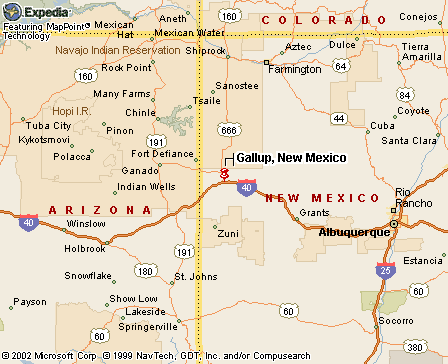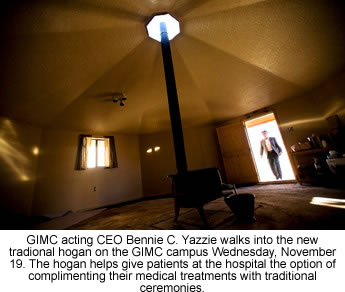 |
Canku Ota
|
 |
|
(Many Paths)
|
||
|
An Online Newsletter
Celebrating Native America
|
||
|
December 1, 2008 - Volume
6 Number 3
|
||
|
|
||
|
No place like a hogan
|
||
|
by Karen Francis - Gallup
Independent Diné Bureau
|
||
|
credits: photos by Cable
Hoover - Gallup Independent
|
|
'It's about time' for a hogan at GIMC
Earlier this year complaints were being made that GIMC was not providing traditional medicine options. Now the GIMC has opened the $18,000 hogan and is constructing two sweat lodges which should open in January. More than that, the medical center is also establishing an Office of Native Medicine and a traditional Navajo practitioner is scheduled to join the staff next week. "We're bringing traditional medicine to collaborate with Western medicine," GIMC Chief Executive Officer Bennie C. Yazzie said. He added that the IHS leadership in Rockville, Md., is pushing for all facilities to provide traditional health care options. After he became acting CEO, Yazzie decided the construction of a hogan should be pursued, and in September 2007, he got the traditional medicine committee back together, appointing staff members from a variety of disciplines. "For the longest time, people were asking for a facility like this," he said. GIMC was one of only two Navajo Area IHS hospitals that did not have a hogan on site and the only one without a sweat lodge. Even the Rehoboth McKinley Christian Health Care Services and NCI have those types of facilities, Yazzie said. "We were sort of the last one joining the program," Yazzie said. Providing traditional health care is important because of the significant health disparities among Native Americans, Dr. Adriann Begay said. The opportunity to build such a hogan came from a Las Cruces couple Begay and her husband knew. When Cookie Cleaver passed away, one of her last wishes was to donate money to the hospital where Begay works. Doug Cleaver contacted Begay about his wife's wish and became the major contributor for the construction of the hogan. Yazzie said that the hogan is available now for anyone that requests to use it. It's also open beyond normal hours. "The
patient now can have access to this facility and their practitioner
doesn't have to worry about taking their jish (medicine bag) into
the hospital. They can come over here and wait for the patient to
be brought over," Yazzie said. Earlier this week, the staff lost a young nurse to an automobile accident and services were provided there for those who wanted to use it. Some have pointed out that the hogan is traditionally located on the north side of the home, but Yazzie said GIMC simply doesn't have the land to do that. However, the hogan is still a welcome addition for the medical center. For Michael Arviso, who is on the traditional medicine committee, the facility is a good thing to help him reconnect to his culture. "For me, being a younger person, I see it as a good thing to get back to our culture and not losing that part of ourselves that is instilled in us since we were born," he said. Yazzie
said the hogan is needed because traditional practitioners are often
hesitant to go into a hospital. The practitioner is an important part of traditional medicine and one will be on staff soon. One of the benefits of having a traditional practitioner on staff is to increase cultural sensitivity at the hospital. One example is that the practitioner hired will provide cultural sensitivity training for staff who are not from around here or have not worked with many Native Americans. The practitioner will most likely also have a role such as those within Chinle Service Unit, which the GIMC has been working with recently in developing its Native medicine program. Yazzie said that Chinle has many success stories and he was very impressed with the role of the practitioner in the treatment of the patient. "According to them, once a patient works with a Western doctor, that patient can be referred to a practitioner who could also work with them, especially if they have questions why they are given certain medication," Yazzie said. "The practitioner would actually take the time to explain using the Navajo way of explaining, like the bodily function and why the medication was prescribed. Through that — the involvement of the practitioner — we understand patients, especially the elderly patients, they're more adherent to taking their medication." Carla Baja Alchesay, chair of the traditional medicine committee, said, "The hogan is part of a bigger dream and a vision of the staff. It will be under an Office of Native Medicine that was also designed and planned by the traditional medicine committee with support from the executive staff through Mr. Yazzie here." Patients who want to use the services of a Native practitioner but don't know one can be helped by the Office of Native Medicine, Yazzie said. The plan is to get a registry with local practitioners. The other plan is for the GIMC to complete the construction of the two sweat lodges, also on the southwestern side of the hospital. Dennis Taliman, who is also on the traditional medicine committee, said that using the sweat lodge can help patients who need counseling.
One of those demands comes from behavioral health, Begay said. Alchesay said that Gallup isn't on the reservation and there are many young people in the area who cannot make it home but want to participate in a sweat ceremony. The goal with the new facilities and Office of Native Medicine is mostly to provide services for Native Americans, since IHS is for all Native Americans. The GIMC serves patients who are Navajo, Zuni, Hopi, Laguna, White Mountain Apache and many other tribes. |
 Gallup, New Mexico map |
www.expedia.com |
|
|
||
|
|
||
| Canku Ota is a free Newsletter celebrating Native America, its traditions and accomplishments . We do not provide subscriber or visitor names to anyone. Some articles presented in Canku Ota may contain copyright material. We have received appropriate permissions for republishing any articles. Material appearing here is distributed without profit or monetary gain to those who have expressed an interest. This is in accordance with Title 17 U.S.C. Section 107. | ||
|
Canku Ota is a copyright ©
2000, 2001, 2002, 2003, 2004, 2005, 2006, 2007, 2008 of Vicki Barry
and Paul Barry.
|
||
 |
 |
|
|
The "Canku
Ota - A Newsletter Celebrating Native America" web site and
its design is the
|
||
|
Copyright ©
1999, 2000, 2001, 2002, 2003, 2004, 2005,
2006, 2007, 2008 of Paul C.
Barry.
|
||
|
All Rights Reserved.
|
||
 GALLUP
— Last week, Indian Health Services officials opened a new
hogan at the Gallup Indian Medical Center with a blessing and dedication
ceremony. The hogan is located on the southwest side of the hospital,
and GIMC staff said the most heard comment has been, "It's about
time."
GALLUP
— Last week, Indian Health Services officials opened a new
hogan at the Gallup Indian Medical Center with a blessing and dedication
ceremony. The hogan is located on the southwest side of the hospital,
and GIMC staff said the most heard comment has been, "It's about
time." "That's
one of the things that we thought we need," he said. "There is a
big demand for sweat lodges."
"That's
one of the things that we thought we need," he said. "There is a
big demand for sweat lodges."